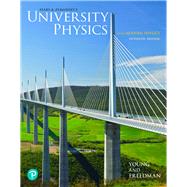For courses in calculus-based physics.
Practice makes perfect: Guided practice helps students develop into expert problem solvers
Practice makes perfect. The new 15th Edition of University Physics with Modern Physics draws on a wealth of data insights from hundreds of faculty and thousands of student users to address one of the biggest challenges for students in introductory physics courses: seeing patterns and making connections between problem types. Students learn to recognize when to use similar steps in solving the same problem type and develop an understanding for problem solving approaches, rather than simply plugging in an equation.
This new edition addresses students’ tendency to focus on the objects, situations, numbers, and questions posed in a problem, rather than recognizing the underlying principle or the problem’s type. New Key Concept statements at the end of worked examples address this challenge by identifying the main idea used in the solution to help students recognize the underlying concepts and strategy for the given problem. New Key Example Variation Problems appear within new Guided Practice sections and group problems by type to give students practice recognizing when problems can be solved in a similar way, regardless of wording or numbers. These scaffolded problem sets help students see patterns, make connections between problems, and build confidence for tackling different problem types when exam time comes.
The fully integrated problem-solving approach in Mastering Physics gives students instructional support and just-in-time remediation as they work through problems, and links all end-of-chapter problems directly to the eText for additional guidance.
Personalize learning with Modified Mastering Physics
By combining trusted author content with digital tools and a flexible platform, Mastering personalizes the learning experience and improves results for each student.Now providing a fully integrated experience, the eText is linked to every problem within Mastering for seamless integration between homework problems, practice problems, textbook, worked examples, and more.
NOTE: Before purchasing, check with your instructor to confirm the correct ISBN. Several versions of the MyLab® and Mastering® platforms exist for each title, and registrations are not transferable. To register for and use MyLab or Mastering, you may also need a Course ID, which your instructor will provide.
Used books, rentals, and purchases made outside of Pearson
If purchasing or renting from companies other than Pearson, the access codes for the Mastering platform may not be included, may be incorrect, or may be previously redeemed. Check with the seller before completing your purchase.











